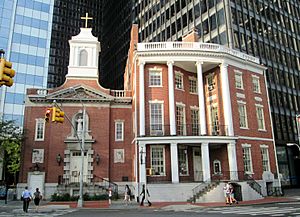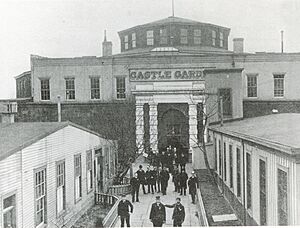James Watson House facts for kids
|
James Watson House
|
|

James Watson House (right) next to the Shrine of St. Elizabeth Ann Bayley Seton
|
|
| Location | 7 State Street, Manhattan, New York City |
|---|---|
| Built | 1793, 1806 (extension) |
| Architect | John McComb, Jr. (west ext., attributed) |
| Architectural style | Federal, Georgian |
| NRHP reference No. | 72000891 |
Quick facts for kids Significant dates |
|
| Added to NRHP | July 24, 1972 |
The James Watson House is a historic building in New York City. It stands at 7 State Street in the Financial District of Manhattan. Built in 1793, it was made larger in 1806. Today, it serves as the rectory for the Shrine of St. Elizabeth Ann Bayley Seton. The house is located very close to the southern tip of Manhattan Island. It is also right across from Battery Park.
Contents
A Look Back: History of the House
Early Days and Important Owners
The James Watson House was once part of a row of grand homes. These homes belonged to rich merchant families. They chose to live near the harbor for amazing views. Being close to their ships also made business easier.
The first owner was James Watson. He was a very important person in early American politics. He served in the New York State Assembly and both the New York and U.S. Senates. Watson was a successful businessman who imported and exported goods.
In 1806, Watson sold the house to Moses Rogers. Rogers was related to Archibald Gracie, who built the famous Gracie Mansion. Moses Rogers bought the house next door and joined it with his own. He added a large porch with columns to make the front look unified. Some say these columns were made from old ship masts! The architect for the newer part of the house was likely John McComb, Jr..
As New York City grew, many wealthy families moved further north. The James Watson House then became an office for a shipping company. During the Civil War, the United States government used it. After the war, it became the main office for the Harbor's Pilot Commissioners. These officials guided ships safely into the harbor.
Helping Immigrants: A New Purpose
In the late 1800s, many people left Ireland for America. They were looking for a better life. A large number of these immigrants were young, single women.
Charlotte Grace O'Brien was an Irish activist. She saw the terrible conditions immigrant women faced. They often had expensive and crowded places to stay. Sometimes, they were even robbed. In 1882, she opened a safe home for these women in Ireland. She also checked on the ships they would travel on. Then, she sailed to New York to see what happened when they arrived.
She worked with important church leaders in America. One was Archbishop John Ireland. Another was Cardinal John McCloskey of New York. They helped set up a special office at Castle Garden. This was the main place where immigrants arrived in New York. They also wanted a chaplain, a priest, just for immigrants.
The Mission of Our Lady of the Rosary
On January 1, 1884, the Mission of Our Lady of the Rosary for the Protection of Irish Immigrant Girls opened. Its first chaplain was Rev. John J. Riordan. At first, girls needing a place to stay were sent to local boarding houses. Soon, a special home for them opened at 7 Broadway.
In 1885, the Mission bought the James Watson House at 7 State Street. This house became a safe stop for young immigrant women. Rev. Riordan was the first Director of the Mission. After he passed away, Rev. Hugh J. Kelly and then Rev. Michael Callaghan took over.
The Mission helped thousands of young women. They worked to make sure steamship companies treated immigrants better. They guided new arrivals who needed to travel further by train or boat. The house on State Street provided a home for about 70,000 girls. These were girls whose friends or family did not meet them. Or, they had no one waiting for them. The Mission also helped find relatives for those with incomplete addresses. They even found jobs for over 12,000 young women, mostly in house work. A chapel inside the house offered spiritual comfort.
The James Watson House is recognized as a very important building. It was named a New York City Landmark in 1965. In 1972, it was added to the National Register of Historic Places.
See also
 In Spanish: Casa James Watson para niños
In Spanish: Casa James Watson para niños



